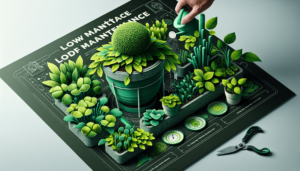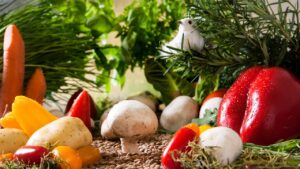Soil is a crucial element in the success of any vegetable garden. It is the foundation from which your plants grow, providing essential nutrients and a stable environment. However, not all soils are created equal, and choosing the suitable soil for your garden can make all the difference in the health and productivity of your vegetables. This article will explore the various factors to consider when selecting soil for your vegetable garden, including soil composition, pH levels, and drainage. By understanding these essential elements, you can create the optimal growing conditions for your beloved vegetables and ensure a bountiful harvest.
Importance of Choosing the Right Soil
One of the most crucial factors in growing a thriving vegetable garden is the type of soil you choose. The soil you select plays a vital role in providing the optimal growth conditions for your plants, ensuring nutrient availability, water retention, and proper drainage. Understanding the soil composition and selecting the right type for your vegetable garden can create a fertile environment that promotes healthy plant growth and high yields.
Understanding Soil Composition
Understanding the composition of soil is essential for choosing suitable soil for your vegetable garden. Soil comprises various components: texture, structure, pH level, and organic matter content.
Texture
Soil texture refers to the relative proportions of sand, silt, and clay particles. Sandy soil has larger particles, allowing for excellent drainage but less water and nutrient retention. Clay soil has smaller particles, which can lead to poor drainage and compaction, but retains water and nutrients well. Loamy soil, considered ideal for gardening, is a balanced mixture of sand, silt, and clay, offering good drainage, water retention, and nutrient availability. Silt soil consists mainly of silt particles, providing characteristics similar to loamy soil. Peat soil, rich in decomposed organic matter, is acidic and has high water retention.
Structure
Soil structure refers to the arrangement of soil particles into clumps or aggregates. Good soil structure allows for air, water, and roots to move, promoting healthy plant growth. Well-structured soil has a crumbly texture and is not easily compacted, allowing roots to penetrate and access necessary nutrients and water.
pH Level
The pH level of soil measures its acidity or alkalinity. Most vegetables prefer a slightly acidic to neutral pH range of 6.0 to 7.0. Adjusting the pH level of your soil can be done by adding lime to raise pH or sulfur to lower pH, ensuring that your plants can efficiently absorb essential nutrients.
Organic Matter Content
Organic matter includes decomposed plant and animal materials and enhances soil fertility. It improves soil structure, water-holding capacity, and plant nutrient availability. Adding compost, manure, and other organic amendments can increase the organic matter content, enriching the soil and creating a favorable environment for vegetable growth.
Types of Soil for Vegetable Gardens
Different soil types have varying properties and are suitable for various plants and gardening practices. Understanding the characteristics of each soil type will help you make an informed decision for your vegetable garden.
Sandy Soil
Sandy soil consists of larger particles and feels gritty to the touch. It drains quickly and warms up faster in the spring, making it suitable for early planting. However, sandy soil has low water and nutrient retention, requiring frequent watering and fertilization. Adding organic matter and mulch can improve water and nutrient retention in sandy soil.
Clay Soil
Clay soil has fine particles that hold water and nutrients well but can become compacted easily, hindering root growth and aeration. It tends to drain poorly and can slowly warm up in the spring. Amending clay soil with organic matter, like compost or well-rotted manure, can improve its drainage and structure, making it more suitable for vegetable gardening.
Loamy Soil
Loamy soil is a balanced mixture of sand, silt, and clay particles, providing excellent drainage, water retention, and nutrient availability. Its crumbly texture allows for proper root development and aeration. Loamy soil is often referred to as the ideal soil type for vegetable gardening due to its versatility and ability to grow a wide range of plants with less need for amendment.
Silt Soil
Silt soil contains many fine silt particles and is smooth to the touch. It has properties similar to loamy soil, offering good drainage, water retention, and nutrient availability. Amending silt soil with organic matter can further improve its structure and fertility.
Peat Soil
Peat soil is rich in decomposed organic matter and has a high water retention capacity. It is acidic and may require pH adjustment for optimal plant growth. Due to its characteristics, peat soil is commonly used as a soil amendment rather than as the primary soil for vegetable gardening.
Testing Your Soil
Before planting your vegetable garden, it’s essential to test your soil to determine its nutrient content, pH level, and any necessary amendments. Soil testing provides valuable information that allows you to make informed decisions and optimize your garden’s success.
Soil Testing Kits
Soil testing kits are readily available and provide a convenient way to test your soil at home. These kits typically include pH testing strips or a color-changing solution to determine the pH level and tests for essential nutrients like nitrogen, phosphorus, and potassium. Follow the kit’s instructions to collect soil samples and interpret the results, making adjustments as needed.
Professional Soil Testing
Consider sending your soil samples to a professional laboratory for more comprehensive and accurate analysis. These labs provide detailed reports that include nutrient levels, pH analysis, and recommendations for soil amendments based on your specific garden needs. Professional soil testing can be particularly beneficial if you are experiencing persistent issues with your soil or want to maximize productivity.
Amending the Soil
Various amendments can be added to enhance the fertility of your soil, providing essential nutrients, improving drainage, and improving overall structure.
Compost
Compost is a rich source of organic matter and nutrients. It can be made using kitchen scraps, yard waste, and other organic materials, which decompose over time. Mixing compost into your soil adds vital organic matter, improves soil structure, and enhances plant nutrient availability.
Manure
Well-rotted manure, such as aged cow, horse, or chicken manure, is an excellent source of organic matter and nutrients. It enriches the soil, improves water-holding capacity, and contributes essential macronutrients and micronutrients that promote healthy plant growth. However, ensure the manure is fully decomposed and properly aged to avoid burning plants or introducing weed seeds.
Cover Crops
Cover crops, such as clover, legumes, or buckwheat, can be grown during the off-season or between planting cycles to improve soil health. When turned into the soil, these crops help reduce soil erosion, suppress weed growth, and add organic matter.
Perlite or Vermiculite
Perlite and vermiculite are lightweight, non-toxic materials that can be added to soil to improve drainage and aeration. Perlite is made from volcanic glass, while vermiculite is derived from a mineral that expands when heated. Both help prevent soil compaction and enhance root growth by allowing better airflow.
Peat Moss
Peat moss is a natural, moisture-absorbing material that helps retain water in sandy soils and enhances water retention in other soil types. It also improves soil structure and provides organic matter, although its use has become a topic of debate due to environmental concerns.
Considerations for Container Gardening
Container gardening offers flexibility in growing vegetables in limited spaces or areas with unsuitable soil conditions. Choosing the suitable soil for your containers is crucial to the success of your plants.
Container Size and Drainage
Select containers appropriate for the size and root depth of your vegetable plants. Adequate drainage is essential to prevent waterlogged soil, which can lead to plant stress and root rot. Ensure that your containers have drainage holes, and consider using a saucer or elevating them slightly to allow excess water to escape.
Potting Mixes and Soil Amendments
Potting mixes are specially formulated to provide a lightweight, well-draining environment suitable for container gardening. They often contain a mixture of peat moss, vermiculite, perlite, and organic fertilizers. Add organic compost or slow-release fertilizers to provide essential nutrients throughout the growing season.
Watering and Fertilizing
Container plants require more frequent watering than traditional garden beds, as they dry out faster. Check the moisture levels regularly and provide enough water to keep the soil evenly moist but not soggy. Fertilize your container plants regularly with a balanced liquid fertilizer to compensate for the nutrients that may be leached out with frequent watering.
Importance of Crop Rotation and Soil Health
Crop rotation is essential for maintaining soil health and preventing pest and disease problems in your vegetable garden. By rotating your crops each growing season, you can minimize the risk of soil-borne diseases, optimize nutrient cycling, and maximize overall plant health.
Crop Rotation Benefits
Crop rotation breaks the life cycle of pests and diseases that may have specific host preferences. Different plant families have varying nutrient and water requirements, which can deplete or enhance specific soil nutrients. By rotating crops, you can alternate nutrient demands and reduce nutrient imbalances, providing a healthier growing environment for your plants.
Soil-Borne Diseases Prevention
Many plant diseases reside in the soil, waiting for susceptible hosts to grow. By rotating your vegetable crops, you minimize the likelihood of diseases spreading or persisting in the soil. Some diseases, such as tomato blight or clubroot in brassicas, can remain in the soil for years. Crop rotation helps disrupt the cycle and reduce the impact of these diseases on your plants.
Nutrient Cycling
Different vegetable crops have varying nutrient requirements. By rotating crops and changing their location each season, you ensure the soil’s nutrients are more evenly distributed and utilized. Some plants are heavy nitrogen feeders, while others fix nitrogen or have lower nutrient requirements. Rotating crops optimizes nutrient cycling in the soil and reduces the need for excessive fertilization.
Soil Maintenance and Care
Maintaining healthy soil is an ongoing process that requires regular care and attention. Implementing a few essential practices ensures that your soil remains fertile and conducive to robust plant growth.
Weeding
Regular weeding helps control the competition for nutrients and water between your vegetable plants and unwanted weeds. Remove weeds promptly to prevent them from robbing your plants’ valuable resources and reduce the risk of harboring pests or diseases.
Mulching
Applying mulch around your vegetable plants can provide numerous benefits. Mulch helps regulate soil temperature, reduces moisture evaporation, suppresses weed growth, and adds organic matter to the soil as it decomposes. Organic mulches like straw, shredded leaves, or wood chips are excellent choices for vegetable gardens.
Watering
Proper watering is crucial for maintaining healthy soil. Water your vegetable garden deeply, ensuring the moisture reaches the root zone. Rinse in the morning to allow excess moisture to evaporate during the day and reduce the risk of fungal diseases. Avoid overwatering, as it can lead to waterlogged soil, root rot, and nutrient leaching.
Fertilizing
Regular fertilization is necessary to replenish nutrients that may become depleted over time. Use organic or slow-release fertilizers to give your plants a steady supply of nutrients. Follow the instructions on the fertilizer packaging and avoid excessive use, as it can harm your plants and negatively impact soil health.
Soil Sterilization
Sometimes, soil sterilization may be necessary to control stubborn soil-borne diseases or pests. Soil sterilization involves heating the soil to kill pathogens, weed seeds, and insect larvae. This process can be done through solar, steam, or chemical sterilization. However, soil sterilization should be used sparingly, as it can also harm beneficial microorganisms and disrupt the natural balance of the soil ecosystem.
Common Soil Problems and Solutions
Several common soil problems can affect the health and productivity of your vegetable garden. Understanding these issues and implementing appropriate solutions is essential to maintain optimal soil conditions.
Poor Drainage
Poor drainage can lead to waterlogged soil, which deprives plant roots of oxygen and hinders their growth. Add organic matter like compost to improve drainage, increase the soil’s porosity, and promote better water movement. Raised beds or container gardening can also help overcome poor drainage issues, providing more control over the growing environment.
pH Imbalance
An imbalanced pH level can affect nutrient availability for your plants. If your soil is too acidic, add lime to raise the pH. If it is too alkaline, add sulfur or organic matter like compost to lower the pH. Regular soil testing will help you identify pH imbalances and take appropriate corrective measures.
Nutrient Deficiencies
Nutrient deficiencies can manifest as yellowing leaves, stunted growth, or poor fruit development. Adding organic matter, such as compost or well-rotted manure, can help improve nutrient availability in the soil. Additionally, organic or slow-release fertilizers formulated explicitly for vegetable gardens can provide a balanced supply of essential nutrients.
Soil Erosion
Soil erosion can occur due to strong winds or heavy rainfall, losing valuable topsoil and nutrients. Implementing erosion control measures like terracing, contour planting, or using windbreaks can help prevent soil erosion. Mulching can also protect the soil from erosion by reducing water runoff and increasing water infiltration.
Resources for Obtaining Quality Soil
Finding quality soil for your vegetable garden ensures successful plant growth. Several resources can help you obtain the suitable soil for your gardening needs.
Local Nurseries and Garden Centers
Local nurseries and garden centers often offer a selection of high-quality soils formulated explicitly for vegetable gardens. These soils are typically enriched with organic matter and balanced nutrients and designed to optimize plant growth. Garden center experts can assist in selecting the best soil for your specific needs and provide valuable advice on gardening techniques.
Online Suppliers
Online suppliers offer various soil and soil amendments that can be conveniently delivered to your doorstep. They often provide detailed product descriptions, customer reviews, and recommendations to help you make an informed decision. When ordering online, ensure that the supplier has a good reputation and positive feedback regarding the quality of their products.
Community Composting Sites
Many communities have composting sites where residents can obtain compost or other organic soil amendments for free or at a minimal cost. These sites often accept organic waste from households and businesses, turning it into nutrient-rich compost suitable for gardening. Check with your local municipality or community organizations to find out if any community composting sites are available in your area.
Choosing the suitable soil for your vegetable garden ensures optimal plant growth, productivity, and overall success. By understanding soil composition, testing your soil, amending it as needed, and implementing proper gardening practices, you can create a fertile environment that supports healthy plant growth and bountiful harvests. Incorporating crop rotation, maintaining soil health, and addressing common soil challenges will contribute to your vegetable garden’s long-term viability and sustainability. Your vegetable garden will thrive With suitable soil and care, providing a rewarding and enjoyable gardening experience.



